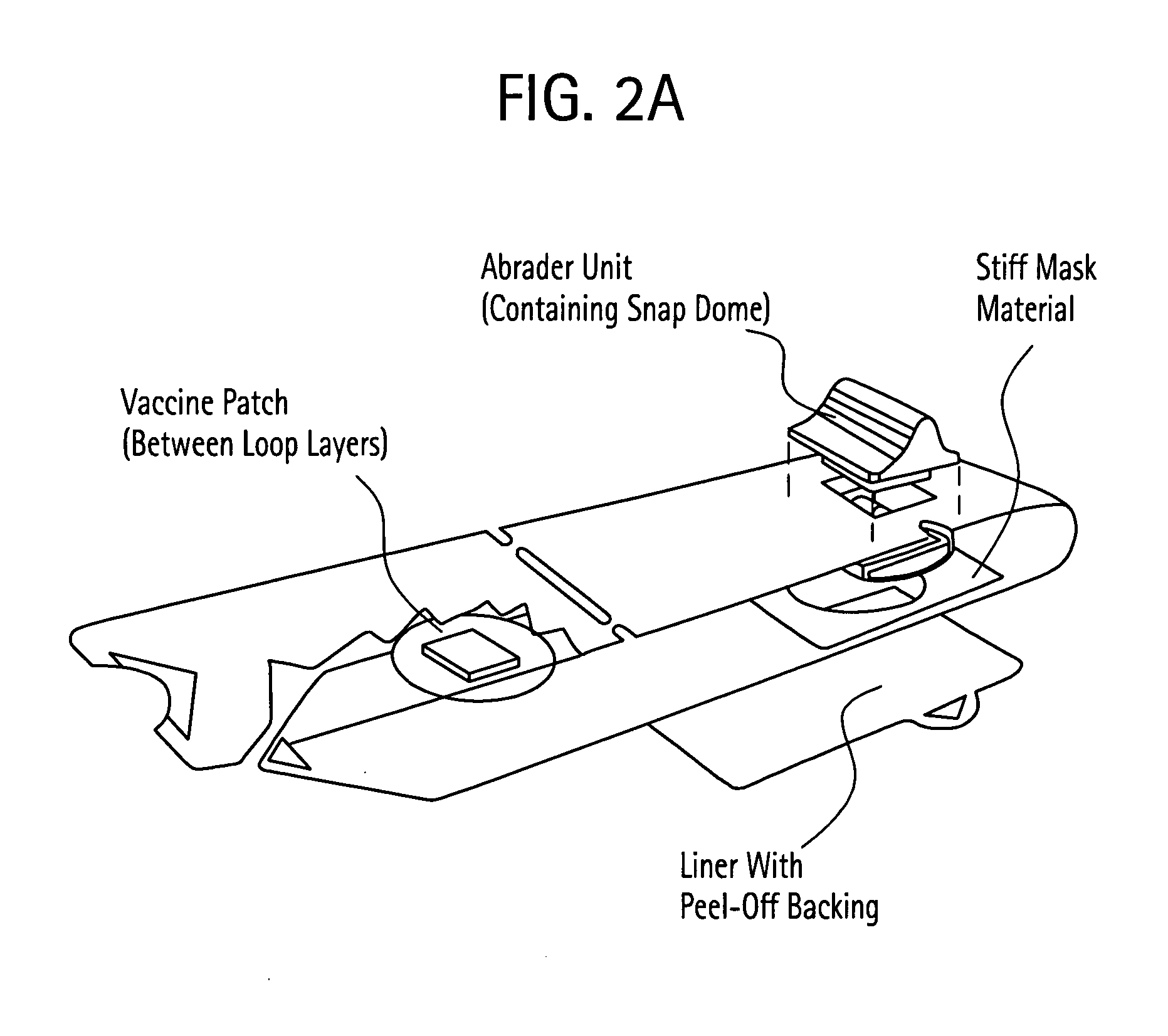Devices for transcutaneous delivery of vaccines and transdermal delivery of drugs and uses thereof
a technology of transdermal delivery and vaccines, applied in the field of vaccines and drug delivery devices, can solve problems such as preventing the effective delivery of therapeutic agents via the skin
- Summary
- Abstract
- Description
- Claims
- Application Information
AI Technical Summary
Benefits of technology
Problems solved by technology
Method used
Image
Examples
example 1
Studies of SPS Using Animals
[0206] General Animal Study Methods: Four SPS surfaces were evaluated in these studies. 1) SPS™-SP is a strip-pull device with a strip of 180 grit sandpaper (7.5 cm length and 2.5 cm width). The strip-pull was equipped with a 700 gram snap dome, which was used to control the force applied during the treatment. 2) Chemical etching (CE) is a process used to precisely modify metal surfaces. In this application, thin stainless steel strips were produced with ridges (edges) on the surface. The surfaces were designed to have one or two rows made up of 6 or 9 ridges per row. CE strips with a single row of ridges were 3.5 cm in length and 3.0 cm wide. CE strips with two rows of ridges were 7.5 cm in length and 3.0 cm wide (SPS™-CE 6 / 9 and SPS-CE 2×6). Ridge height was also investigated over the range of 100 μm to 250 μm. The CE strips were mounted on strip-pull devices equipped with 700 gram or 1100 gram snap dome. 3) SPS™-ME3 (micro-edge) is a third design usin...
example 2
Strip Pull Device
[0227] In this example, an area of guinea pig skin was shaved and various methods of disruption were administered—hydration, tape stripping, and abrasion with strip pull. The strip had dimensions of 1 inch in width by 2.25 inches in length. For the strip pull device, the abrasive material was 3M 431Q Tri-M-Ite sandpaper, and grit ranging from 120-180 was employed. The abrasive was pulled across the guinea pig skin with at least 700 grams of pressure constantly applied. Patches containing different amounts of LT adjuvant (0.15 micrograms and 15 micrograms, respectively) were applied to different treatment groups, and serum IgG anti-LT titer levels were observed after 21 days using ELISA. The data in Table 1 show that the geometric mean titer levels were significantly greater using the strip pull device than the titer levels for hydration or tape stripping at equivalent LT doses.
TABLE 1Strip Pull LT Geometric Mean TiterHydrationonlyTape strippingStrip PullLT0.15150...
example 3
Site and Spin Device
[0228] In this example, guinea pigs were primed with HA trivalent flu antigen, then after 21 days, an area of guinea pig skin was shaved and barrier disruption methods including hydration, abrasion with GE Medical ECG non-woven abrasive pad, and abrasion with a site and spin device of the invention were employed. The abrasive employed in the site and spin device was 3M 431Q Tri-M-Ite 180 grit sandpaper, and it was rotated 9 times on the guinea pig skin in less than 1 second. Operators were instructed to apply firm pressure of approximately 500 grams; force was not mechanically controlled in this example, although it could be controlled in other embodiments of the invention. A patch containing LT adjuvant (0 or 5 micrograms) and trivalent flu antigen (HA, 15 micrograms) was then applied overnight, and serum IgG titer levels observed 21 days later using ELISA. The data in Table 2 show that the geometric mean titer of serum IgG against all three flu strains was gre...
PUM
 Login to View More
Login to View More Abstract
Description
Claims
Application Information
 Login to View More
Login to View More - R&D
- Intellectual Property
- Life Sciences
- Materials
- Tech Scout
- Unparalleled Data Quality
- Higher Quality Content
- 60% Fewer Hallucinations
Browse by: Latest US Patents, China's latest patents, Technical Efficacy Thesaurus, Application Domain, Technology Topic, Popular Technical Reports.
© 2025 PatSnap. All rights reserved.Legal|Privacy policy|Modern Slavery Act Transparency Statement|Sitemap|About US| Contact US: help@patsnap.com



